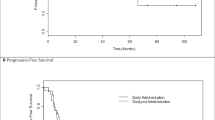Abstract
In the present single institution study of 66 leukaemia patients (28 AML, 23 ALL, 15 CML), the factors influencing haematological recovery after allogeneic bone marrow transplantation (alloBMT) were analysed retrospectively to identify the optimal conditions required for rapid haematological recovery after alloBMT. All patients received GVHD prophylaxis with cyclosporine A plus methotrexate. The mean number of days required to achieve a neutrophil count ≥0.5×109/l after alloBMT was 17 (range 9–27), 19 patients (28.8%) had rapid neutrophil recovery within 15 days after alloBMT. Haematological recovery was more rapid in the 38 patients without GVHD or with only grade I GVHD. Also, 50% and 40% of patients receiving 10 (n=18) or 5 (n=20) μg/kg G-CSF per day, respectively, had rapid neutrophil recovery within 15 days after alloBMT, as against only 7.1% of patients not receiving G-CSF after the transplant (n=28);P<0.001. The neutrophil recovery was similar in patients receiving either fresh or cryopreserved allografts and either a TBI-containing or a busulfan-containing conditioning regimen. A significant correlation was found between the neutrophil recovery and either the MNCs or CFU-GM contents of the allografts. The mean number of days required for neutrophil recovery was only 16 (range 9–24) in patients receiving allografts containing >1×105 CFU-GM/kg (n=28), as against 19 (range 13–27) in patients receiving allografts containing ≤1×105 CFU-GM/kg (n=35). Three patients receiving allografts containing <0.5×105 CFU-GM/kg had primary neutrophil engraftment failure. The mean number of days required to achieve a platelet count ≥20×109/l was 21 (range 11–50), and 30 patients (46.9%) had platelet recovery within 20 days after alloBMT. The platelet recovery after alloBMT was not affected by the type of leukaemia, conditioning regimen, or G-CSF administration. The mean number of days required for platelet recovery after alloBMT was 20 in patients receiving allografts containing >1.0×105 BFU-E/kg (n=35), as against 23 days in patients receiving allografts containing ≤1.0×105 BFU-E/kg (n=24). Seven patients receiving allografts containing <0.5×105 BFU-E/kg had primary platelet engraftment failure. The present study has identified the high number of progenitor cells in the allografts infused and the daily administration of G-CSF posttransplant as the optimal combination for rapid neutrophil recovery after alloBMT. More significantly, the number of BFU-E in allografts was the most significant determining factor in platelet recovery after alloBMT. The development of GVHD of grade II or more during the first weeks after alloBMT was associated with slower haematological recovery, a longer period of fever during neutropenia and longer hospitalization.
Similar content being viewed by others
Author information
Authors and Affiliations
Rights and permissions
About this article
Cite this article
Hassan, H., Krog, C., Stockschläder, M. et al. Factors influencing haematological recovery after allogeneic bone marrow transplantation in leukaemia patients treated with methotrexate-containing GVHD prophylaxis . Support Care Cancer 5, 299–306 (1997). https://doi.org/10.1007/s005200050077
Issue Date:
DOI: https://doi.org/10.1007/s005200050077




